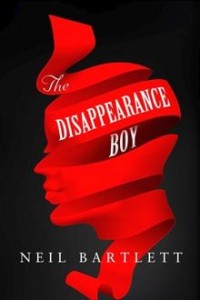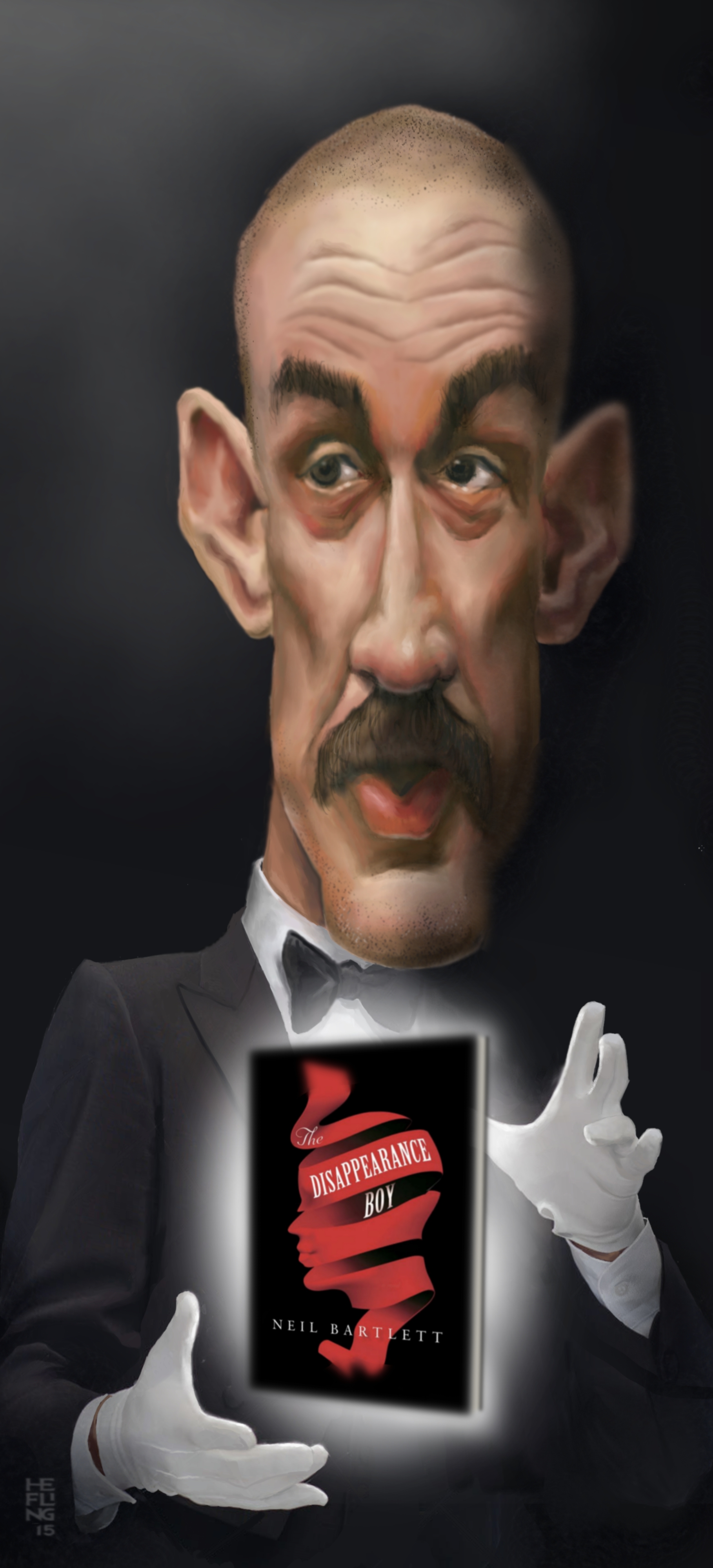 The Disappearance Boy
The Disappearance Boy
by Neil Bartlett
Bloomsbury. 282 pages, $26.
“ALL I’D SAY by way of a warning is that you need to remember that a magician is not someone who deceives, but someone who keeps his promise. Which is to deceive. All right?” We can consider this Neil Bartlett’s warning, or promise, about his most recent novel, Disappearance Boy, which takes magic as its subject. This isn’t magic as in enchantment or magical realism. This is the arduous and precise mechanics of stage magic, the labor behind the illusion, the dynamics and the deceits among the people who create the illusion on stage. That Bartlett creates enchantment anyway is his own brand of magic.
After a startling prelude—a boy stands on railroad tracks, waiting for the approaching train to kill him—the novel takes place in the months leading up to Queen Elizabeth II’s coronation on June 2, 1953. The plot concerns a magician, always referred to as Mr Brookes, who has a run-of-the-mill magic act.
He puts a sexily dressed woman into a box, twirls it, and opens it to show that the woman is gone. Then, in the act’s “reveal,” the woman walks on in splendid new clothes and walks off the stage arm-in-arm with Mr Brookes. The novel starts in London with one woman in the act, Sandra, who leaves and is replaced by another, Pam, who also takes Sandra’s place in Mr Brookes’ bed as the act moves to Brighton. Then there’s Reggie, the disappearance boy, which means that his job is to hide inside the magic apparatus and make the magic work. Reggie—the boy on the tracks, now 22 and stunted because of polio—is gay, although uncertain about what to do with that fact in the world of 1953.
Although it has a story and memorable characters, the novel is not plot-driven. Instead, as if to show off his skill, Bartlett has imposed restrictions on himself. It’s like the magic act itself, a small cast of characters performing a small range of repeated actions: rehearsing, performing, having sex, looking for love. What gives the novel its power is the way in which Bartlett has set up parallels among the actions, so that they comment on and illuminate each other. Some parallels are pointed out explicitly—the narrator has a hovering, intrusive presence, like a magician talking through the trick he is performing.
For example, in this relatively short book, Bartlett goes through the magic act in detail eight times: in rehearsal, in performance, in explaining how it’s done. It’s basically the same act each time, but each time it is shown differently, from a different angle, and the repetition makes us see the difference. The repeated magic act forms the spine of the novel, in a sense supporting what happens offstage.
When the novel proper begins, we’re thrust into a mysterious scene in a theater. Mr Brookes is repeatedly tying Sandra’s wrists with a red cord and glowering at her. The narrator comments: “If the seats out front are empty—and they undoubtedly are—then who is he doing all of this for? The stare before the missing knot gets stonier each time, and the repetition is beginning to look less like rehearsal and more like a punishment. Is it for something that young woman has done, or merely for something that she is?” This first presentation of the act is in fact a punishment in the guise of a rehearsal, for a liberty that Sandra took in the previous night’s performance, and also for what she is, a woman, whose role is to be used and abused.
Here we can see Bartlett at work. This rehearsal parallels, and is part of, the sexual relationship between Mr Brookes and the women in the act. When Sandra thinks that, “after six weeks, she knows a little too much about what those hands can do to her ever to be fully at ease in their company,” she’s thinking about the hands onstage and in bed: bruises result from both. When Pam joins the act, she also finds a parallel, as Mr Brookes shows her the awkward positions required in the box: “She’d come here to get away from men telling her what position to take up next, thank you very fucking much.” When she later surprises herself by falling into Mr Brookes’ bed, there’s another parallel with the magic act: “the whole of life is a quick change act really, isn’t it? And never mind, it’s always the same woman inside the outfit, whatever she’s wearing. It doesn’t change anything, what you’re wearing, does it? I mean, you’re still you, no matter what.”
Even Coronation Day finds a parallel to the act: “Then, at just past one o’clock, the silence broke like a wave; at the  moment when the crown touched the young woman’s head—the moment when her transformation was effected, that is (the reveal, you might even say), people forgot themselves, and started to clap.” Pam finds her own parallel in Margaret, Elizabeth’s earthier sister: “Men were always looking up at Margaret in her pictures, never she up at them, and she liked that—it looked as though she had all the time and choice in the world. All the time in the world.”
moment when the crown touched the young woman’s head—the moment when her transformation was effected, that is (the reveal, you might even say), people forgot themselves, and started to clap.” Pam finds her own parallel in Margaret, Elizabeth’s earthier sister: “Men were always looking up at Margaret in her pictures, never she up at them, and she liked that—it looked as though she had all the time and choice in the world. All the time in the world.”
For Reggie, too, there are parallels between what he does unseen in the act and how he approaches his life: “Even before he could walk entirely unaided the young Reggie had learnt how to squeeze himself and his unusual body away in the gaps in the people’s attention—and to be at home there.” On his free days, he goes to the cemetery to talk to a grave that he has picked to represent his mother’s. This activity started as cruising: “Reggie had first done it when he was nineteen … following a young man in a raincoat who’d looked conspicuously over his shoulder at him from a nearby bus stop.” Now he asks her advice on how to meet someone “special.” (“Special” is another parallel: Pam succumbs to Mr Brookes’ advances when he “breathed out the one word which always undid her. Special.”) The narrator wonders how the reader will respond to Reggie’s activities, thereby establishing yet another parallel with the magic trick: “it’s all an illusion, isn’t it, talking to the dead? I mean, when you think about it, isn’t he doing exactly what Mr Brookes is persuading the punters to do fourteen times a week down at the Grand? Imagine that there’s a woman in an empty box.”
In one chapter, the parallels should seem schematic but instead are deeply moving. The chapter has three scenes, each with one of the characters alone in bed, for different reasons and with different feelings about it. First is Pam, not yet a bed partner for Mr Brookes: “Being alone in a single bed would do her just fine for the present, thank you very much. She’d enjoyed putting it about in her time, but now she was going to try the other thing for a while.” We then see Mr Brookes as his bed partner for the night is leaving: “His limbs instinctively liked it when his overnight guests did the decent thing and got themselves off home before the morning.” Finally, in powerful contrast, we see Reggie, also alone in bed but not willingly. He lies on his side—“a variation on Pam’s position under the stairs” as she is secretly wheeled offstage during the act—and presses each vertebra against the wall: “It is a very exact sensation, and eventually resolves itself into the illusion”—another magic act here—“that there is another, matching spine just beneath the wallpaper, pushing back against his.”
Bartlett has set The Disappearance Boy, like his other novels, in the decades before gay liberation. The period obviously fires his imagination, but he isn’t interested in oppression or societal rejection. Pam’s acceptance of Reggie, for example, is matter-of-fact: “he was a sweet boy, and surely he didn’t have to be such a loner. His sort often were, of course.” As the narrator points out, “Despite what people say now—and despite what most of them assumed, back then—it was very far from the truth that everything was hidden away behind locked doors in the spring of 1953. It wasn’t—not in this town.”
For Bartlett’s gay characters, including Reggie, the problem isn’t societal homophobia but their own isolation, a basic lack of information about how to be gay. A key scene turns homophobia into information. Reggie overhears a group of men joking about getting propositioned under the piers. “That laughter and the men’s careless, white-teethed faces were the pieces of information that Reggie’s restless body now retrieved. Looking up at the flags turning pale around the lamps of North Road, he picked at the memory like a twist of sugar he’d been saving for later—like a short cut; an alleyway on a map, one that the day-trippers never noticed.” And so he goes to the piers.
As he narrates his story, Bartlett also draws parallels between the magic act and the book he is creating. This isn’t the romantic sense of the artist as magician; it’s the writer explaining his tricks, showing how it’s done. Those are in fact the final words of the book: “Here’s how it’s done.” And the first are “Let me try this for an opening.” But the emphasis on the mechanics of writing doesn’t make it any less magical. In this, as in his previous novels—I particularly recommend Ready to Catch Him Should He Fall (1992) and Skin Lane (2007) as essential reading—Bartlett calls attention to his narrative strategies, which has the effect of pointing out the artifice of his books. I find this aspect of his writing intellectually gratifying. Paradoxically, however, the artifice catches me up and makes me, the sophisticated reader, almost in spite of myself, care about these characters and their hopes for happiness. I’m like the audiences at Mr Brookes’ performance: I can’t help letting myself be deceived by the illusion.
Neil Bartlett has kept his promise.
Michael Schwartz is an associate editor of this magazine.






